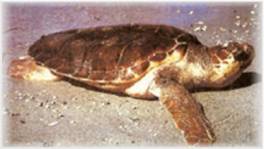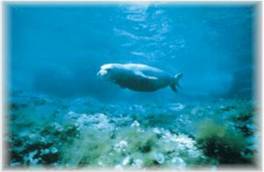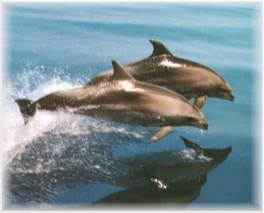|
MARINE
LIFE | |
|
| |
|
THE
SEA TURTLES OF KEFALONIA | |
|
| |
|
The
Loggerhead Sea Turtle, Caretta-caretta the only marine turtle nesting in
Greece and the Mediterranean. Zakynthos is has the largest hatchery left
in the Mediterranean where about 2,000 nests are laid annually. Kefalonia
has a smaller population, with less than 150 nests between Skala and
Lixouri. |
|
|
The
female turtles nest on the southern facing shoreline of the island. Many
of these beaches are so far untouched by human development and therefore
offer the turtles a safe place to nest, secluded from the outside world.
However, in the past 20 years tourist development has been
encroaching into these untouched nesting habitats. The Katelios Group was
founded in 1993 and has observed, monitored and recorded the feeding and
breeding behaviour of the turtles nesting on these sandy beaches.
Incorporating a conservation programme to promote the protection of these
main nesting areas from any rapid development, most are already stable and
therefore offer the females a safe nesting ground to lay their eggs. The
Group currently monitors the nesting behaviour of the turtles on the main
beach at Mounda Bay. With the data collected its being used to produce a
conservation plan in an effort to protect the turtles and their habitats
throughout the island of. Research work starts in the spring, with the
beaches firstly being cleaned of waste deposits left over the winter
months. The beach is then mapped and marked, allowing the exact
positioning of each nest to be recorded. The nesting season is June to
August during this time the beach is monitored nightly from 10.00 pm. to
6.00 am. where every emerging turtle from the sea is recorded. This
includes the length and width of the shell and the health of each female.
The nest position, and the number of eggs in each clutch. The tag numbers
are recorded and turtles without tags are marked. After an incubation
period of around 55days, the hatchlings emerge late at night or early
hours of the morning and make the precarious journey to sea. The numbers
and fate of each hatchling is accounted for After the practical work has
finished the information is collected and reports and petitions are made
to the authorities. With the help and support of the local fisherman and
compensation for any damaged nets, the support and co-existence of people
and turtle, locals and tourists alike is giving valuable support and is
essential in the protection of these nesting grounds. | |
|
| |
|
For more
information contact The Katelios Group for the Research and Protection of
Marine and Terrestrial Life, Katelios, Kefalonia. Tel:
81009-81584
In
addition to this the FNEC is a non-profit making non-governmental
organisation established in June 1998. It also acts as a hosting
organisation running 2 different projects with young volunteers for a
period of 6 months. Showing
the results of its work in their Museum in Fiskardo. For more information
contact Ionian Sea Research Centre, Fiskardo, Kefalonia. Tel
41181-41182 | |
|
| |
|
| |
|
THE
MEDITERRANEAN MONK SEAL | |
|
| |
|
In
1984 the monk seal Monachus
monachus, was identified as one of the twelve most endangered animals
in the world. Less than 500 are thought to remain. Diminished into two
surviving areas, one habitat is the Atlantic coast of northwest Africa and
the other, here in the waters of the Mediterranean. Where they remain
still the most endangered mammal in Europe. |
|
|
They
survive in these waters with another threatened and endangered species,
the sea turtles Caretta caretta. The surviving monk seal
population in Greece has decreased to seriously low levels. Apart from the
common hostility to these marine creatures from fishermen, the disruptive
effects of two world wars and the now rapid progress of industries and the
associated pollution, the most significant factor in the species’ decline
is the accelerated increase in mass tourism and tourist developments along
the coastlines that inevitably brings the increasing disturbance and
destruction of the natural habitats. Not to mention the rapid increase in
pleasure and motorboat activities which, during the breeding and weaning
seasons, are regarded as a major threat to the species. This pursuit of
enjoyment by an inconsiderate minority can cause fear, abandonment of the
pups and unfortunately, in some cases, death. Believe
it or not even in ancient Greece, monk seals were protected, their display of great love for sea
and sun placed them under the guardianship of the gods Poseidon and
Apollo. These animals were mentioned by Homer and Aristotle and even
depicted on one of the first coins to be stamped in 500 bc. The fishermen and seafarers,
who caught sight of the animals playing in the waves or plodding slowly on
the beaches considered that to be a omen of good fortune. Chronicled
throughout history, we have all been made well aware that humans have
hunted seals for their own survival for many hundreds of years. The
trusting and inquisitive nature of these creatures has made them easy prey
for hunters and fishermen who dispatched them instantly using spears, but
when the animals were netted and clubs were used, these savage culls
became a blood bath. The seals were killed mainly for the pelts that went
into making of clothing, shoes and tents giving excellent protection
against adverse weather conditions. The meat of the animal was consumed
with the fat being rendered down for oil to be used in lamps.
Evidence
has suggested that after the fall of the Roman empire the species was
severely depleted. However, a decrease in its necessity, with the
introduction of the more refined olive especially within the Mediterranean
areas may have possibly allowed the monk seal to gain a interim recovery
period, though not to original levels. During the Middle Ages trading in
seal pelts once again peaked in certain regions, practically wiping out
the larger colonies. For the ones that survived a hard lesson was learnt,
they no longer grouped together on open beaches and rocky outcrops, but
instead found refuge in caves and along inaccessible and rocky coast
lines. Consequently today these reclusive creatures hide so well that
little information is now available, but approximate figures suggest about
possibly 200 live in Greek waters. The
Mediterranean monk seals life span is up to 40 years but today mostly only
20 if lucky, with males and females looking almost identical. Males weigh
in at about 315 kg with an average length of 2.4 m. The females are only
slightly smaller, weighing approximately 300 k. Adults are generally brown
or grey on the back. A white patch is common on the underside of the
belly, and others have irregular mottled light patches on the stomach. The
older males tend to be black. Pups are born between 88 -103 cm in length
and weigh 16 -18 kg. The Mediterranean monk seal pups are born with a
white or yellow patch on the stomach and have a black, woolly coat.
The
Mediterranean monk seal has been virtually eradicated from most of its
original habitat by human encroachment and females now pup only in caves
in remote and relatively undisturbed areas. Males and females are thought
to reach sexual maturity between 5 and 6 years, although some females may
mature as early as 4 years. Pups are born during most of the year but
mainly in September and October. Monk seal pups can swim and dive at about
two weeks of age and are weaned at about 16-17 weeks. Their main diet is
fish, octopus and seaweed. If you are lucky enough to see a monk seal, do
not follow it or frighten it disturb any way only observe from a
distance.
| |
|
| |
|
| |
|
THE
DOLPHIN | |
|
| |
|
For
thousands of years the dolphin has been a symbol that in Greece has played
an important role in the cultural and artistic heritage of its people, and
for them it represents an expression of freedom and beauty. No other
animal on the planet has had such a magical connection with humans. Since ancient times the dolphin’s lack of
aggression, sense of fun and ability to contact the deepest human emotion
and spirit has become legendary. |
|
|
Dolphins
are mammals from the whale-porpoise family known as cetaceans which
scientists believe may have evolved from early land mammals that returned
to the sea. Their skeletons have uncanny similarities to ours, and they
have a complex language, each dolphin having a personal signature tune as
unique as a fingerprint. Although they are quite large and powerful
animals there have been no reports of any unprovoked attacks on man but
however many have been known to kill a shark with a single blow. Dolphins
will allow people to grasp their strong dorsal fin for a ride, carry
children on their backs and even leap out of the water next to swimmers.
There have been numerous instances of dolphins saving peoples lives, from
fishermen to swimmers, divers and windsurfers. In the last decade dolphins
have even been used in the treatment of depression. International
Dolphin Watch, an organisation established to protect these mystical
creatures, believe it is essential for the overall well being of dolphins
that they be able to breed, feed and roam in their natural environment.
Unfortunately through the polluting of the Mediterranean as well as the
excessive fishing with the use of fine filament nets, the dolphin
population has been drastically reduced and is continuing to do so in the
sea surrounding Greece. Nowhere is this more evident than around Kefalonia
where in the past dolphins were quite common, chiefly in the deep waters
between Ithaki and Zakynthos. Nonetheless dolphins are still seen
following boats to and from these islands and a small group can usually be
found in the Gulf of Argostoli, especially around the fish farm area. It
is hoped that with the tighter environmental control and stricter
regulations from the EEC and the Greek government, particularly concerning
fishermen, we will once again see these magnificent animals thrive. | |


